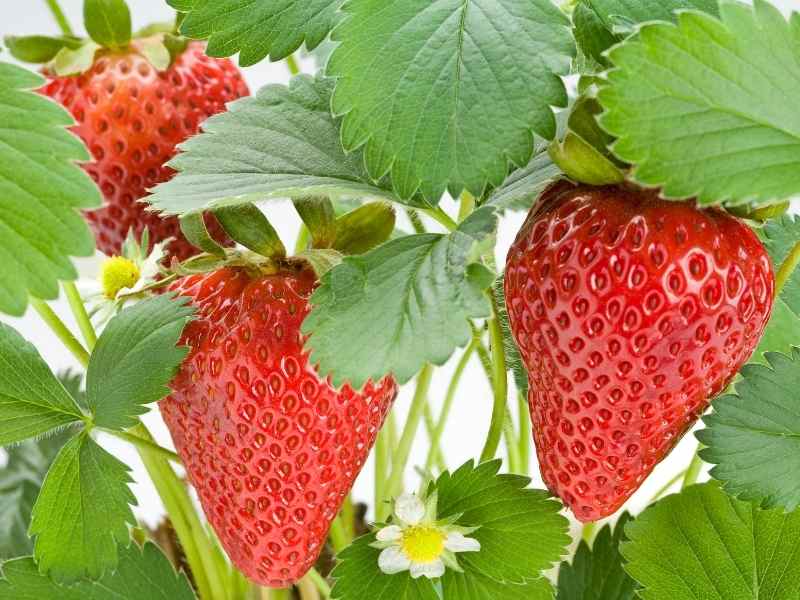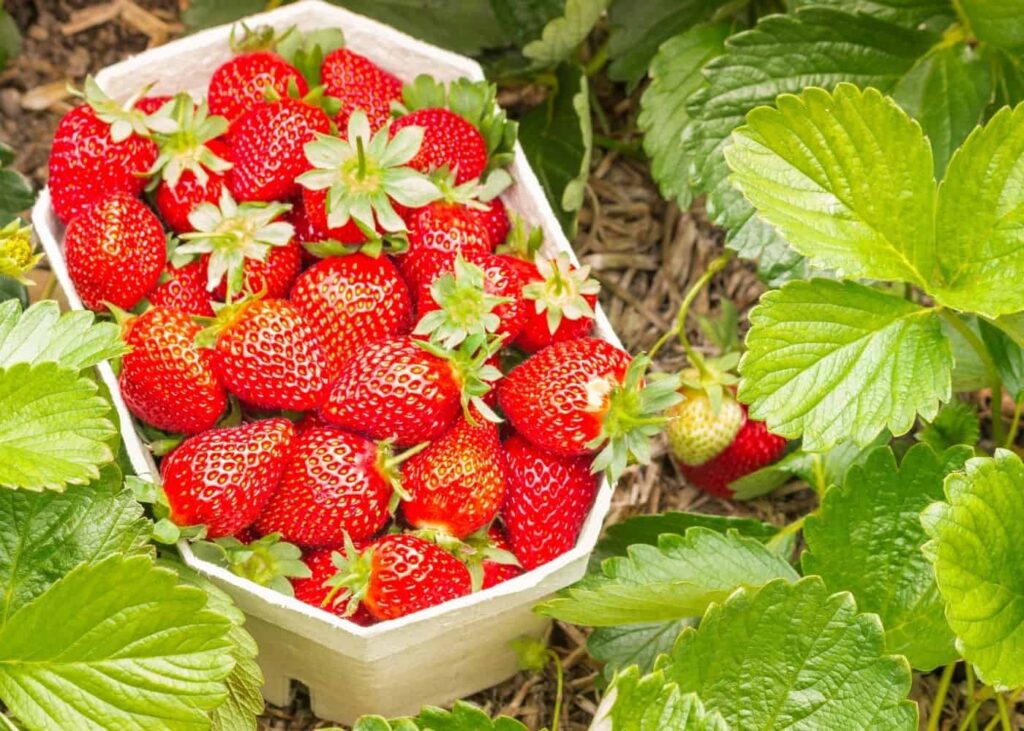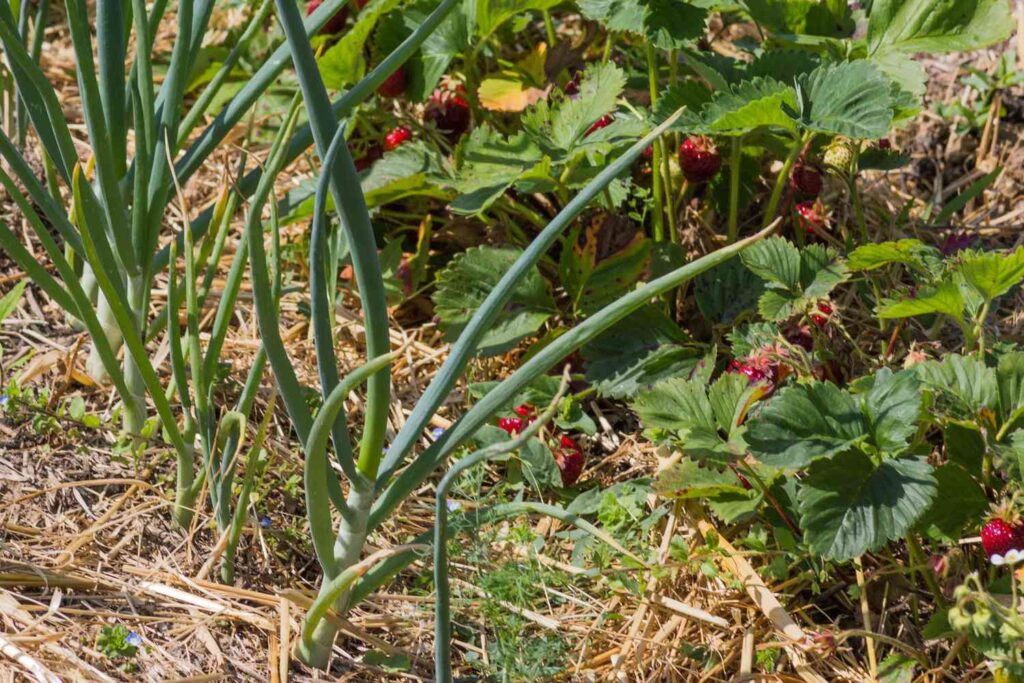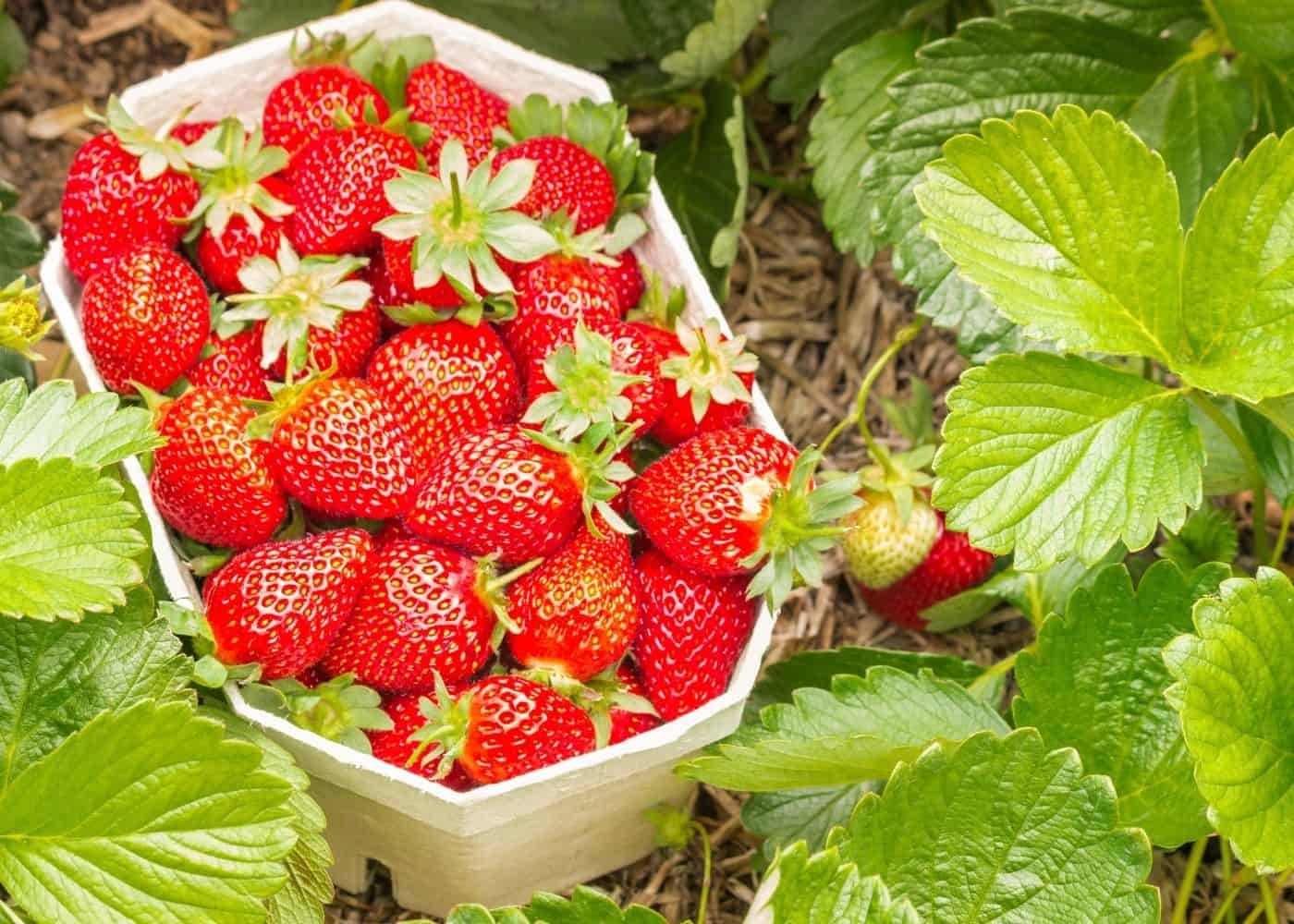In the realm of horticulture, the meticulous cultivation of strawberries demands a profound understanding of the intricate relationships that foster optimal growth. However, not all plants possess the harmonious companionship sought by these prized berries. Thus, it becomes paramount to explore the forbidden alliances that must be avoided. By identifying the plants that should be kept at a distance from strawberries, this article aims to equip gardeners with the necessary knowledge to safeguard the vital well-being of their thriving strawberry plants. Resolute in its commitment to unraveling the secrets of bountiful strawberry cultivation, this scholarly discourse sets out to illuminate the pitfalls of ill-advised plant pairings in the strawberry patch.

Companion Plants to Avoid
Tomatoes
When it comes to companion planting alongside strawberries, it is advisable to avoid planting tomatoes. Tomatoes belong to the nightshade family, just like potatoes and peppers, and they tend to attract similar pests and diseases. Planting tomatoes near strawberries can lead to pest transfer and increased susceptibility to diseases such as blight. It is best to keep these two plants separated to ensure the optimal health and productivity of each.
Peppers
Another vegetable to avoid planting near strawberries is peppers. Peppers, like tomatoes, are from the nightshade family and share similar vulnerabilities to pests and diseases. Planting peppers near strawberries can increase the risk of both plants being affected by common issues such as aphids, blight, and other fungal infections. To prevent potential harm to your strawberry plants, it is advisable to keep peppers at a distance.
Potatoes
Potatoes, also part of the nightshade family, should be kept separate from strawberries as well. The reason behind this is similar to the previous two companion plants. Potatoes are prone to diseases such as late blight, which can easily spread to strawberries if planted nearby. Additionally, planting potatoes near strawberries may attract Colorado potato beetles, which can cause damage to both crops. It is best to ensure a substantial distance between your strawberry patch and any potato plants.
Herbs to Avoid
Mint
While mint can be a lovely addition to any garden, it is best to avoid planting it near strawberries. Mint is known for its invasive nature and can quickly spread throughout your garden. Planting mint near strawberries can result in the mint overpowering and inhibiting the growth of the strawberries. The aggressive growth habit of mint can also make it difficult to control and may lead to competition for resources, such as water and nutrients, which are vital for the health of your strawberry plants.
Chives
Chives, too, should be avoided as a companion plant for strawberries. Although chives can deter certain pests with their strong scent, they can also hinder the growth of strawberries. Chives have similar resource requirements as strawberries, and planting them nearby can lead to competition for vital resources. Additionally, the dense growth of chives can create shade, which strawberries require minimal of. It is advisable to keep chives separate from your strawberry patch to ensure the optimal growth and productivity of your strawberries.
Dill
While dill is an aromatic herb that can attract beneficial insects to your garden, it is not an ideal companion for strawberries. Dill has a tall growth habit that can overshadow and inhibit the growth of strawberries, which prefer full sun. Furthermore, dill can attract pests such as aphids and spider mites, which can subsequently harm the strawberries. It is best to plant dill in a separate area of your garden away from your strawberry plants to prevent potential problems.

Fruits and Vegetables to Avoid
Brassicas
When planning the layout of your garden, it is important to avoid planting brassicas, such as cabbage, broccoli, and cauliflower, near strawberries. Brassicas require a significant amount of space and can block sunlight from reaching the strawberries. Furthermore, brassicas have similar nutrient requirements as strawberries, and planting them together can lead to competition for essential resources. To ensure the health and productivity of your strawberries, it is best to keep them separate from any brassica crops.
Cucumbers
Although cucumbers can be a refreshing addition to your summer salads, they are not ideal companions for strawberries. Cucumbers are heavy feeders and require ample nutrients, which can lead to competition with the strawberries for essential resources. Additionally, cucumbers have a sprawling growth habit, which can hinder the growth and sunlight exposure of strawberries. It is best to avoid planting cucumbers near your strawberry patch to optimize the performance of both crops.
Eggplants
Eggplants, like tomatoes and peppers, are from the nightshade family, making them unsuitable companions for strawberries. In addition to being prone to similar pests and diseases, eggplants can also create competition for resources such as water and nutrients. Moreover, the tall and bushy growth of eggplants can result in shading and overcrowding, limiting the sunlight available to the strawberries. To avoid any adverse effects, it is recommended to keep eggplants away from your strawberry plants.
Onions
While onions are commonly grown alongside various vegetables, they should not be planted near strawberries. Onions release a pungent odor that can repel certain pests, but they can also inhibit the growth of strawberries. Onions have extensive root systems and can compete with strawberries for essential nutrients in the soil. Their dense foliage can also create shade, which strawberries require minimal of for optimal growth. To ensure the vitality of your strawberry plants, it is advisable to plant them away from onions.
Flowers to Avoid
Roses
Although roses are renowned for their beauty and fragrance, they should be avoided as companions for strawberries. Roses are susceptible to various fungal diseases, including black spot and powdery mildew, which can spread to strawberries if planted nearby. Additionally, roses can attract pests such as aphids and Japanese beetles, which can harm strawberry plants. To protect your strawberries from potential diseases and pests, it is best to keep roses at a distance.
Marigolds
Marigolds are often used as companion plants for various vegetables, but they may not be suitable for strawberries. While marigolds can repel certain harmful insects, they may also inhibit the growth of strawberries. Their dense foliage can create shade and compete for resources, causing potential harm to the strawberries. Moreover, marigolds have allelopathic properties, which means they release certain chemicals that can hinder the growth of neighboring plants, including strawberries. To ensure the optimal health of your strawberries, it is advisable to avoid planting marigolds in close proximity.
Sunflowers
Sunflowers, with their striking appearance and ability to attract beneficial insects, may seem like a good companion for strawberries. However, it is best to keep sunflowers away from your strawberry patch. Sunflowers are tall plants that can cast shadows and restrict the sunlight reaching the strawberries. This shade can affect the growth and productivity of the strawberries, which require ample sunlight. To avoid any potential hinderance, it is recommended to plant sunflowers in a separate area of your garden.

Beneficial Plants to Encourage
Borage
Borage is a beneficial companion plant for strawberries due to its attraction of pollinators and ability to deter harmful pests. Borage flowers produce nectar that attracts bees and other pollinators, enhancing the pollination process and aiding in the production of strawberries. Additionally, borage is known to repel pests such as tomato hornworms and cabbage worms, which can reduce the risk of damage to your strawberry plants. By planting borage near your strawberries, you can create a more favorable environment for both the plants and their supporting pollinators.
Lupine
Lupine is another beneficial plant that can be encouraged as a companion for strawberries. Lupine plants are nitrogen-fixing legumes, which means they have the ability to convert atmospheric nitrogen into a form that can be readily used by other plants. By planting lupine near your strawberries, you can provide them with an additional source of nitrogen, essential for healthy growth and fruit production. The presence of lupine can also attract beneficial insects such as ladybugs and lacewings, which help control pests naturally.
Nasturtiums
Nasturtiums are popular companion plants for strawberries due to their several benefits. These vibrant flowers are known to attract pollinators, such as bees and butterflies, improving the fertilization and fruit set of strawberries. Nasturtiums also release a strong odor that can deter pests like aphids and whiteflies, reducing the risk of infestations. Moreover, nasturtiums act as a natural ground cover, suppressing weed growth and reducing competition for resources with the strawberry plants. Consider planting nasturtiums near your strawberries to enhance their overall health and productivity.
Common Problems of Companion Planting
Competition for Resources
One common issue with companion planting is the competition for resources among different plants. When plants share the same space and have similar resource requirements, such as water, sunlight, and nutrients, they can hinder each other’s growth and productivity. This competition can lead to stunted growth, reduced fruit or flower production, and overall weaker plants. Therefore, it is crucial to consider the resource needs of each companion plant and ensure adequate spacing to minimize competition and promote plant health.
Disease and Pest Transfer
Another potential problem with companion planting is the transfer of diseases and pests between plants. Some plants are more susceptible to certain diseases or pests, and when they are planted in close proximity, there is an increased risk of spreading these issues. This can result in widespread damage and decreased crop yields. It is essential to research the specific diseases and pests associated with each plant and avoid planting susceptible varieties together. Regular monitoring and prompt action, such as removing infected plants, can help minimize the spread of diseases and pests in companion planting systems.

Planting Strawberries with Other Berries
Raspberries
While strawberries and raspberries can be planted together, it is important to provide ample spacing to prevent competition. Raspberries have a spreading growth habit and can quickly dominate the area, shading the strawberries and restricting their growth. It is recommended to plant strawberries and raspberries in separate rows or designated areas, ensuring they have enough room to thrive without hindering each other. By carefully planning and providing proper spacing, you can enjoy the benefits of both berries in your garden.
Blueberries
Blueberries and strawberries can make excellent neighbors in the garden, as they have similar soil and moisture requirements. However, it is crucial to consider the difference in their growth habits. Blueberries are large shrubs that can grow much taller and wider than strawberry plants. To prevent overcrowding and shading, it is best to plant blueberries in a separate area or staggered rows to allow ample sunlight and space for both crops. This approach will ensure optimal growth and harvest for both the strawberries and blueberries.
Blackberries
Like raspberries, blackberries have a sprawling growth habit, which can create challenges when planting them alongside strawberries. To avoid competition and overcrowding, it is recommended to keep blackberries and strawberries in separate rows or designated areas. This spacing will provide better access to sunlight and airflow, reducing the risk of diseases in both crops. By establishing appropriate distances between blackberries and strawberries, you can cultivate a harmonious and productive berry garden.
Strawberry Pest Control
Slugs and Snails
Slugs and snails can be common pests in strawberry patches, as they are attracted to the ripening fruit and tender leaves. To control these pests, you can utilize various approaches. One option is to create physical barriers around the strawberry plants, such as copper tape or a layer of diatomaceous earth, as slugs and snails dislike crossing these surfaces. Another method is to encourage natural predators of slugs and snails, such as frogs, toads, and birds, by providing suitable habitats and water sources in your garden. Additionally, regular inspection and handpicking of slugs and snails can be an effective control method, particularly during the early morning or evening when they are more active.
Aphids
Aphids are small insects that can infest strawberry plants and cause damage by sucking the sap from leaves and stems. To manage aphid populations, several approaches can be employed. One method is to introduce beneficial insects, such as ladybugs, lacewings, or parasitic wasps, which naturally prey on aphids. Another option is to use organic insecticidal soaps or horticultural oils, which can effectively control aphids without harming beneficial insects. Additionally, practicing good garden hygiene, such as removing weeds and regularly inspecting plants for signs of aphids, can help prevent infestations.
Spider Mites
Spider mites are tiny pests that can be challenging to detect but can cause significant damage to strawberry plants. These pests feed on the plant’s sap, resulting in yellowing leaves, stunted growth, and webbing. To manage spider mite infestations, it is important to regularly inspect the undersides of strawberry leaves for signs of mites or webbing. Introducing predatory mites, such as Phytoseiulus persimilis, can be an effective biological control method. Additionally, spraying plants with a strong jet of water can dislodge spider mites, reducing their populations. If necessary, insecticidal soaps or botanical insecticides labeled for mite control can also be used, following the instructions carefully.

Supporting Plants for Strawberries
Clover
Clover is a beneficial plant that can be used as ground cover for strawberry beds. Clover has nitrogen-fixing properties, which means it can convert atmospheric nitrogen into a form usable by plants. This additional source of nitrogen can enhance the growth and productivity of strawberries. Clover also acts as a natural mulch, suppressing weed growth and reducing soil erosion. Its dense growth can assist in moisture retention and provide shade for the shallow roots of strawberries. By interplanting clover with strawberries, you can improve the overall health and vigor of your strawberry plants.
Comfrey
Comfrey is another supporting plant that can benefit strawberries. Comfrey has deep roots that are capable of extracting nutrients from the subsoil, making these nutrients available to shallow-rooted plants like strawberries. The nutrient-rich leaves of comfrey can be used as a natural fertilizer by mulching or composting them around the base of the strawberry plants. Comfrey also attracts beneficial insects, such as bees, which can enhance pollination in your strawberry patch. By incorporating comfrey into your garden design, you can promote the long-term health and productivity of your strawberry plants.
Feverfew
Feverfew, an aromatic herb, can serve as a supportive plant for strawberries. Feverfew is known for its ability to repel certain pests, such as aphids and spider mites. By interplanting feverfew with strawberries, you can help protect the strawberry plants from these harmful insects, reducing the need for chemical interventions. Feverfew also attracts beneficial insects like ladybugs, hoverflies, and lacewings, which are natural predators of pests. Additionally, feverfew’s daisy-like flowers can add aesthetic appeal to your strawberry patch. By incorporating feverfew as a companion plant, you can create a more balanced and resilient ecosystem in your garden.
Tips for Successful Strawberry Planting
Rotate Crops
To maintain the health and productivity of your strawberry plants, it is crucial to practice crop rotation. Avoid planting strawberries in the same area year after year, as this can lead to a buildup of soil-borne diseases and depletion of nutrients. Instead, rotate strawberries with unrelated plant families, such as beans or lettuce, on a three to four-year cycle. This practice helps prevent the recurrence of diseases and maintains soil fertility, ensuring robust and fruitful strawberry plants.
Provide Adequate Spacing
Proper spacing is essential for the optimal growth and development of strawberry plants. Adequate spacing allows for better airflow, which reduces the risk of diseases and promotes pollination. When planting strawberries, ensure a distance of 12 to 18 inches between individual plants and maintain rows at least 24 inches apart. This spacing allows each plant to receive sufficient sunlight, nutrients, and water, resulting in healthy and productive strawberry plants.
Monitor for Diseases
Regular monitoring is crucial for detecting and managing diseases in strawberry plants. Inspect your plants frequently for any signs of discoloration, wilting, or abnormalities in growth. Common diseases in strawberries include powdery mildew, gray mold, and verticillium wilt. If you notice any symptoms, promptly remove and destroy affected plants to prevent the spread of the disease. Additionally, practicing good garden hygiene, such as cleaning tools, removing debris, and avoiding overhead irrigation, can help minimize the risk of disease outbreaks. By staying vigilant and proactive, you can maintain healthy strawberry plants and maximize your harvest.
In conclusion, selecting the right companion plants for strawberries plays an important role in their overall health and productivity. By avoiding certain plants like tomatoes, peppers, and potatoes, you can prevent the transfer of diseases and pests. Herbs such as mint, chives, and dill should also be kept separate from strawberries due to issues of competition and growth inhibition. Similarly, certain fruits and vegetables like brassicas, cucumbers, eggplants, and onions can be detrimental to strawberry plants if planted too close. Additionally, flowers such as roses, marigolds, and sunflowers should be avoided as companions for strawberries. On the other hand, beneficial plants like borage, lupine, and nasturtiums can enhance the overall well-being of strawberries and attract beneficial insects for pollination and pest control.
When it comes to growing strawberries with other berries, careful planning and spacing are crucial to prevent competition and shading. While raspberries and blueberries can be planted alongside strawberries, maintaining proper distances is essential to ensure each crop receives adequate sunlight and resources. Blackberries, with their sprawling growth habit, should be given dedicated space to avoid overcrowding and competition with strawberries. Incorporating supporting plants like clover, comfrey, and feverfew can provide additional benefits such as nitrogen fixation, nutrient availability, pest repellence, and attractiveness to beneficial insects.
Successful strawberry planting also requires attention to common problems such as competition for resources and disease and pest transfer. Managing these issues includes providing proper spacing, practicing crop rotation, and promptly addressing any signs of diseases or infestations. By following these practices and guidelines, you can cultivate thriving and fruitful strawberry plants, ensuring a bountiful harvest year after year.



